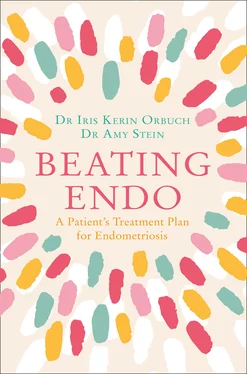Affording it was going to be tough. At age thirty-eight, Elena was still paying off student loans. She had been the first person in her family to go to college, but even taking six years to do it—so she could work between semesters—didn’t pay for everything, and she had had to borrow tuition money. On the plus side, she was good at managing expenses, and she lived with a partner who valued her health as much as she did. What Iris was telling her made the disease that stalked her life at long last something she could get her head around, something she might potentially control . It was the first step to beating her endo, and it was clearly worth whatever financial hardships came with it.
Buttressing that notion of control, Iris recommended a few first steps of treatment, starting with pelvic floor physical therapy—a specialty of the physical therapy practice. She gave Elena a list of such specialists, and Elena, a New Yorker, made an appointment at Amy’s practice. The cost would go well beyond what Elena’s insurance plan would cover; Elena calculated quickly and decided that the new sofa she was eyeing for the apartment could easily be put off.
Next, Iris turned to Elena’s interstitial cystitis/painful bladder syndrome, giving her a blueprint for an organic, low-acid, low-potassium, anti-inflammatory diet. She also referred Elena for an ultrasound to rule out the possibility of her having an ovarian cyst; the presence of such a cyst is the only imaging finding that ultrasound can reveal.
Equally important was the education Elena got about the difference between ablation surgery and excision surgery. Iris explained why excision was the proper treatment for endo, and why ablation had not worked for her. “Ablation is superficial; it burns off the top layer of an endo lesion—the surface only. Excision cuts out and removes your endo.” But even though excision is the right procedure, it should be performed only when the body has been sufficiently cooled down from the upregulation the endo has set in motion. Think of endo as the first domino in the row, Iris suggested; when it falls, it sets all the other dominoes tumbling, one after another. What Elena had to understand, Iris told her, was that she needed to address all the “co-condition dominoes” before she could return to the endo domino that had toppled them into her life.
“You think your endo is the cause of everything,” Iris told her, “but in fact it’s endo and its coexisting conditions. As we identify all the conditions and find a treatment plan for each, you will begin to downregulate your central nervous system, and as you do, you will feel your pain and discomfort diminishing. So start with the diet and the PT to begin treating the interstitial cystitis and the tight pelvic floor muscles, and come back to me in six weeks. And bring the records of your operation and your past medical history so I can learn more. I want to make sure we cover all the bases before we schedule excision surgery.” Bottom line: Excision is the right surgery, there is a right time for doing it—after you’ve separated out and begun to deal with all the coexisting conditions.
Elena understood at once that she would have to postpone more than just the new sofa in order to pay for the surgery when the time came. It would not be easy, but it would clearly be essential. In Elena’s pyramid of necessary expenses, PT for right now and excision surgery for soon enough rose to the top, displacing repayment of student loans, the sofa, and the dream Caribbean vacation she and her partner had planned. Health first.
When Elena returned to see Iris six weeks later, she could report that she was urinating less frequently and was now “committed” to her new low-acid, low-potassium, anti-inflammatory eating regimen. She had even recognized that tomatoes, citrus, and coffee aggravated her symptoms; she knew this because she had cheated slightly, reintroducing those items, which had produced instant reactions. Now, needless to say, she was “off” tomatoes, oranges, and black coffee for good.
A less frequent need to urinate also meant that Elena was getting more sleep at night, so she was less tired, so she felt stronger, better, more confident about what she was doing for her health. And while the first couple of sessions of PT seemed to have introduced a new and different discomfort, Amy had explained it was because her muscles were just so tight that trying to lengthen and relax them would leave her sore. “Ever have a massage?” Amy asked. “The same way a massage that kneads the muscles deeply can leave you feeling sore, this initial flare-up of pain is a message that what you’re doing is working.” Elena could sense it too; she could literally feel that her muscles had a long way to go to relax, and after seven sessions of PT, she began to feel that happening. Moreover, her PT team at Amy’s office worked with her on her bladder and bowel habits, helping her to recognize when she was squeezing involuntarily so she could begin to un-squeeze and relax the muscles instead. They also urged her to start using a Squatty Potty, perhaps the best known of the so-called toilet tools—a valid extra expense if ever there was one.
She was still bleeding heavily, and she was still in pain, but she could see a glimmer of hope through it all. As Iris told her, “You’re thirty-eight and have been in pain since you were fifteen. You can’t get rid of twenty-three years of pain in six weeks, but the fact that you’re noticing a difference in only six weeks is promising: It means that your central nervous system is responding, and that this multimodal treatment plan is working. It won’t happen overnight, but you can see that change is coming.” Exactly so, and the glimmer seemed electric.
One part of the plan Elena had not yet had time to follow up on was to consult a specialist who could help her deal with her upregulated central nervous system. So Iris now referred her to a physiatrist who combined Eastern practices of mindfulness and meditation and Western advances in medical treatment to calm the central nervous system. Both approaches are needed, Iris argued. Learning how to meditate was powerful, but often not enough to cool the system on its own. Ditto for taking a pill: Pharmacology can be powerful but far less so when it acts single-handedly. Both together—meditation and the drug, Eastern and Western wisdom—are what cool the central nervous system and help restore the body to balance and efficiency.
The specialist alerted Elena that he would be starting her on a low dose of the medication he prescribed and would then increase the dosage incrementally. It meant she would not feel the drug’s effects for at least a month, maybe longer, as she worked her way up to that “therapeutic” level of intake. Too much of this medication too soon, the specialist warned Elena, could cause unpleasant and serious side effects. He also advised her to download a mindfulness app and spend ten minutes in mindfulness-based stress reduction each morning. She would at least start her day in a downregulated frame of mind and body—“Almost as good as an island vacation,” she told herself. But the specialist also recommended she start a serious meditation practice and/or begin seeing a talk therapist or pain psychologist.
Having experienced the benefits of her efforts so far, Elena embraced these ideas. She also felt she had gained a clearer picture of the multiple different causes of her pain. What she had thought was her “stage one endo” she now recognized as multiple coexisting conditions. She was beginning to understand in the most immediate terms how different actions raised the heat of her central nervous system. But she also wanted to know when she could have surgery.
“I could operate on you tomorrow,” Iris replied, “but I would be a really bad doctor if I did that. I would be doing you a disservice. Let’s cool your body down a bit more and wait about six to twelve weeks before we schedule your surgery. Continue the PT regularly, stay true to the diet, take the meds and do the mindfulness practices the physiatrist prescribed, and you will be well primed for surgery.”
Читать дальше











